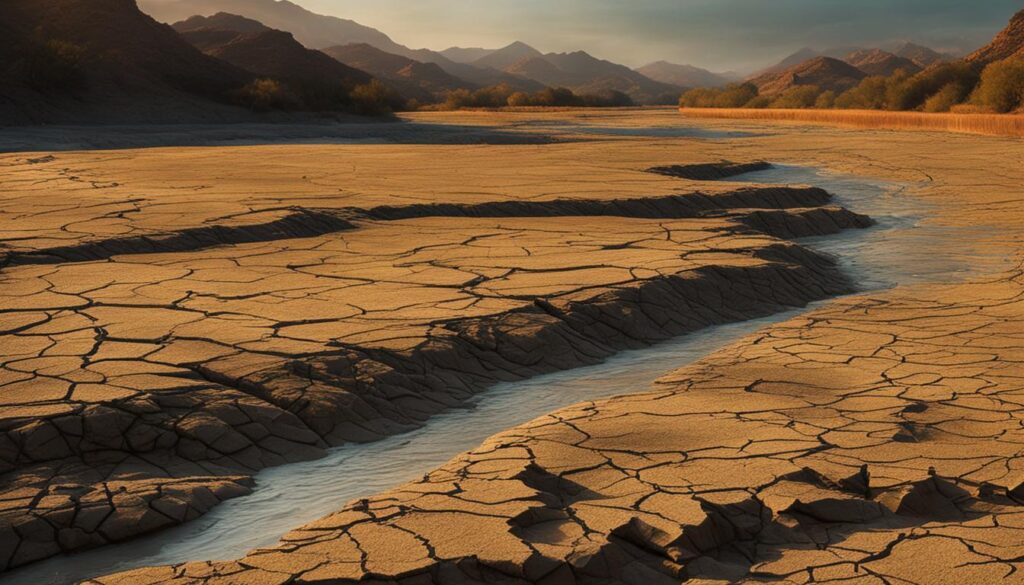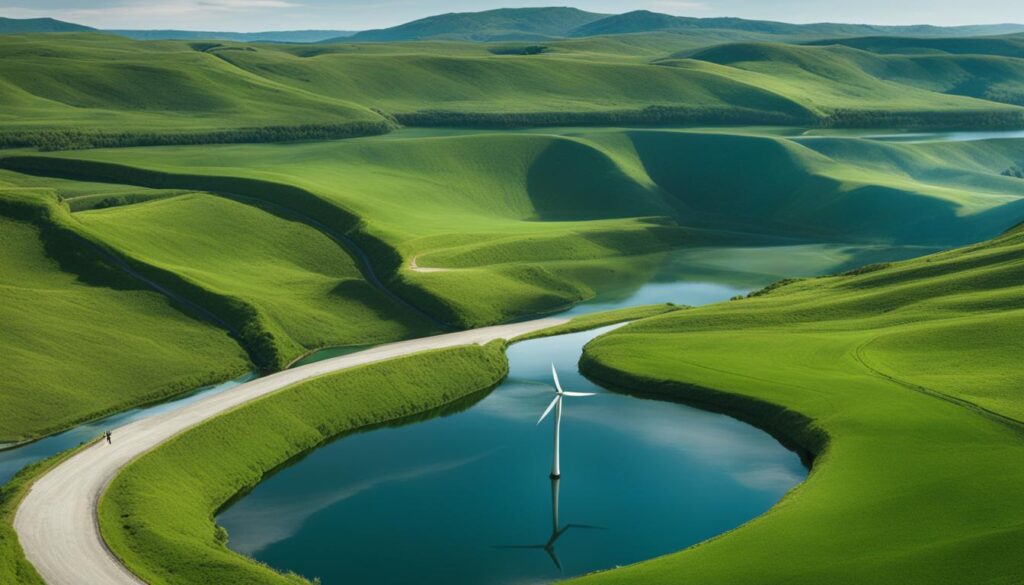Climate change is having a profound impact on water resources worldwide. As temperatures rise and precipitation patterns change, water scarcity is becoming an increasingly prevalent issue. It is crucial to invest in sustainable water solutions to address this challenge and ensure a reliable water supply for future generations.
Investing in water resources can help mitigate the effects of climate change on water scarcity. By improving water infrastructure, promoting efficient water resource management, and finding innovative solutions, we can safeguard our water supply and enhance climate resilience.
In this article, we will explore the link between climate change and water scarcity, discuss the importance of investing in water resources for a sustainable future, delve into integrated water resources management for climate adaptation, and conclude with the key takeaways.
Key Takeaways:
- Climate change is exacerbating water scarcity issues globally.
- Investing in water resources is crucial for building a sustainable future.
- Integrated Water Resources Management is essential for adapting to climate change impacts on water resources.
- Efficient water allocation systems and improved infrastructure are key to water resource management.
- Prioritizing water conservation, resource management, and resilience is crucial in the face of climate challenges.
The Link Between Climate Change and Water Scarcity
Climate change has a profound impact on water resources, exacerbating the issue of water scarcity. Rising temperatures and changing precipitation patterns disrupt the natural water cycle, leading to decreased water availability and compromised water quality. As a result, communities around the world are facing significant challenges in accessing clean, safe water for their daily needs.
To address the water scarcity problem in the face of climate change, it is crucial to implement climate adaptation strategies that promote sustainable water management. Water conservation and efficiency measures play a vital role in optimizing water usage and reducing wastage. By adopting these practices, we can ensure that water resources are utilized more efficiently, allowing for better resilience in the face of changing climate conditions.
Investing in sustainable water solutions and infrastructure is also essential for combating water scarcity. Developing sustainable water sources, such as rainwater harvesting systems and desalination plants, can help diversify water supplies and reduce reliance on traditional sources. Additionally, investment in water infrastructure, including the construction of storage facilities and the improvement of distribution networks, can enhance water resilience and better prepare communities for the impacts of climate change.
Climate Adaptation Strategies for Water Scarcity
In order to effectively manage water resources amidst climate change, it is crucial to explore and implement climate adaptation strategies. These strategies aim to build resilience and mitigate the impacts of climate change on water availability. Some key adaptation measures include:
- Water-efficient agriculture: Promoting sustainable agricultural practices that optimize water usage and minimize water-intensive activities.
- Water recycling and reuse: Implementing systems that treat and reuse wastewater for non-potable purposes, reducing the strain on freshwater sources.
- Groundwater management: Employing measures to monitor and protect groundwater resources, preventing over-extraction and contamination.
- Water pricing and governance: Implementing policies that incentivize responsible water usage and prioritize water allocation to ensure equitable access for all.
“Water scarcity is a critical challenge exacerbated by climate change. By implementing climate adaptation strategies and investing in sustainable water solutions, we can ensure a reliable water supply for future generations.”
By adopting these climate adaptation strategies and investing in sustainable water solutions, we can work towards mitigating the impacts of climate change on water resources and building a more resilient future. It is imperative that governments, businesses, and individuals collaborate to prioritize water conservation and resource management, safeguarding this vital resource for generations to come.

Investing in Water Resources for a Sustainable Future
Investing in water resources is a critical step towards building a sustainable future in the face of climate change. By allocating funds towards water infrastructure, we can improve water supply and distribution systems, enhance water quality, and support climate resilience. These investments not only contribute to water security but also offer opportunities for economic growth and environmental stewardship.
One key area of investment is in water security. Building storage facilities, such as reservoirs and tanks, can help mitigate the impact of climate change on water resources by ensuring a reliable supply during periods of scarcity. Additionally, implementing efficient irrigation systems can minimize water wastage and increase agricultural productivity, promoting food security in the face of changing climatic conditions. By investing in these water security measures, we can safeguard communities and industries from the uncertainties of a changing climate.
Another avenue for investment is through sustainable water funds. These funds provide an opportunity for individuals and organizations to contribute to water conservation efforts, industry innovation, and community resilience. By supporting projects that promote water efficiency, ecosystem restoration, and water education, investors can play a significant role in addressing water scarcity challenges. Sustainable water funds also offer a platform for collaboration between stakeholders, fostering partnerships that can drive positive change in water resource management.
Investing in Water Infrastructure: A Smart Choice for the Future
“Water is the driving force of all nature.” – Leonardo da Vinci
Leonardo da Vinci’s quote underscores the essential nature of water and the significance of investing in its sustainable management. By prioritizing investments in water infrastructure, we can build a future where clean and reliable water is accessible to all. Whether through implementing climate-resilient water systems, promoting water conservation practices, or fostering innovative technologies, investing in water resources is a smart choice for the future.
| Benefits of Investing in Water Resources | Examples |
|---|---|
| Improved water supply and distribution | Upgrading water treatment plants and pipelines |
| Enhanced water quality | Investing in advanced filtration technologies |
| Climate resilience | Building water storage facilities for drought mitigation |
| Economic growth | Creating jobs in water infrastructure development |
| Environmental sustainability | Supporting projects to restore and protect water ecosystems |
Investing in water resources is not only an investment in our future but also a commitment to ensuring the well-being of communities, industries, and ecosystems. By prioritizing sustainable water solutions and infrastructure development, we can build a resilient and water-secure world in the face of climate change.

Integrated Water Resources Management for Climate Adaptation
Integrated Water Resources Management (IWRM) is a holistic approach that aims to address the challenges posed by climate change on water resources. It recognizes the interconnectedness of various water sectors and emphasizes the need for integrated planning and management strategies to ensure water security and resilience against climate impacts.
Effective water resource management is crucial in the face of climate change and has the potential to mitigate water investment risks. By adopting IWRM principles, countries can develop comprehensive strategies that take into account the multiple dimensions of water management, including supply, demand, quality, and environmental considerations.
Key components of Integrated Water Resources Management:
- Water governance: Establishing clear roles, responsibilities, and coordination mechanisms among stakeholders to ensure effective decision-making and the implementation of water management plans.
- Water allocation and planning: Balancing competing demands for water resources through efficient allocation mechanisms and long-term planning strategies that account for the impacts of climate change.
- Water infrastructure: Investing in the development and maintenance of water infrastructure, such as dams, reservoirs, and water treatment plants, to improve water storage, distribution, and quality.
- Water conservation and efficiency: Implementing measures to reduce water wastage and improve water-use efficiency in sectors such as agriculture, industry, and domestic consumption.
- Environmental protection: Incorporating ecosystem-based approaches in water management to maintain the health and functioning of aquatic ecosystems, which are crucial for supporting water resources.
By adopting IWRM principles, countries can enhance their adaptive capacity to climate change and minimize water investment risks. This comprehensive approach ensures that water resources are managed sustainably, promoting water security and resilience in the face of a changing climate.

| Benefits of Integrated Water Resources Management | Challenges of Integrated Water Resources Management |
|---|---|
| – Improved water allocation and planning | – Stakeholder coordination and cooperation |
| – Enhanced water security and resilience | – Limited financial resources for investment |
| – Increased efficiency in water use | – Data and information gaps |
| – Protection of ecosystems and biodiversity | – Institutional and governance challenges |
Conclusion
Climate change poses significant challenges to water resources globally, including increased water scarcity and the need for adaptation. Investing in water resources, implementing sustainable water solutions, and improving water resource management are critical for safeguarding the future.
Integrated Water Resources Management offers a comprehensive approach to address climate change impacts on water resources. By adopting this holistic approach, countries can better adapt to the consequences of climate change on water availability and quality, while reducing investment risks.
It is imperative to prioritize investments and strategies that promote water conservation, resource management, and resilience in the face of a changing climate. By taking action now, we can ensure access to clean and reliable water for future generations, mitigating the adverse effects of climate change on water resources.
FAQ
How is climate change affecting water resources globally?
Climate change is leading to increased water scarcity and impacting water availability and quality worldwide. Rising temperatures and changing precipitation patterns are affecting water resources.
What are the solutions to address water scarcity in the face of climate change?
Solutions include implementing climate adaptation strategies such as water conservation and efficiency measures, developing sustainable water sources, and investing in water infrastructure.
Why is investment in water resources crucial?
Investing in water resources improves water supply and distribution systems, enhances water quality, and supports climate resilience. It also helps mitigate the impacts of climate change on water resources.
What is Integrated Water Resources Management (IWRM) and how does it help with climate change adaptation?
IWRM is a holistic approach that considers the sustainable development and management of water resources in the context of climate change. By implementing IWRM, countries can better adapt to climate change impacts on water resources and reduce investment risks.
Why is effective water resource management important for climate resilience?
Effective water resource management ensures water security and resilience in the face of climate challenges. It helps in improving water infrastructure, promoting water conservation, and finding solutions to water scarcity amid climate change challenges.
Why is Investing in Water Resources a Strategy for Diversification During Climate Change?
Investing in water resources is increasingly recognized as a viable strategy for diversification during climate change and investment diversification. As the effects of climate change intensify, water scarcity becomes a prominent concern. Incorporating investments in water resources, such as water infrastructure, treatment technologies, and conservation measures, can help mitigate risks and ensure long-term stability in the face of climate-related challenges. Such a diversified approach provides opportunities for both financial growth and environmental sustainability.


Pingback: Green Gold: Unearthing Investment Opportunities in a Climate-Conscious World! – Straight Fire Money